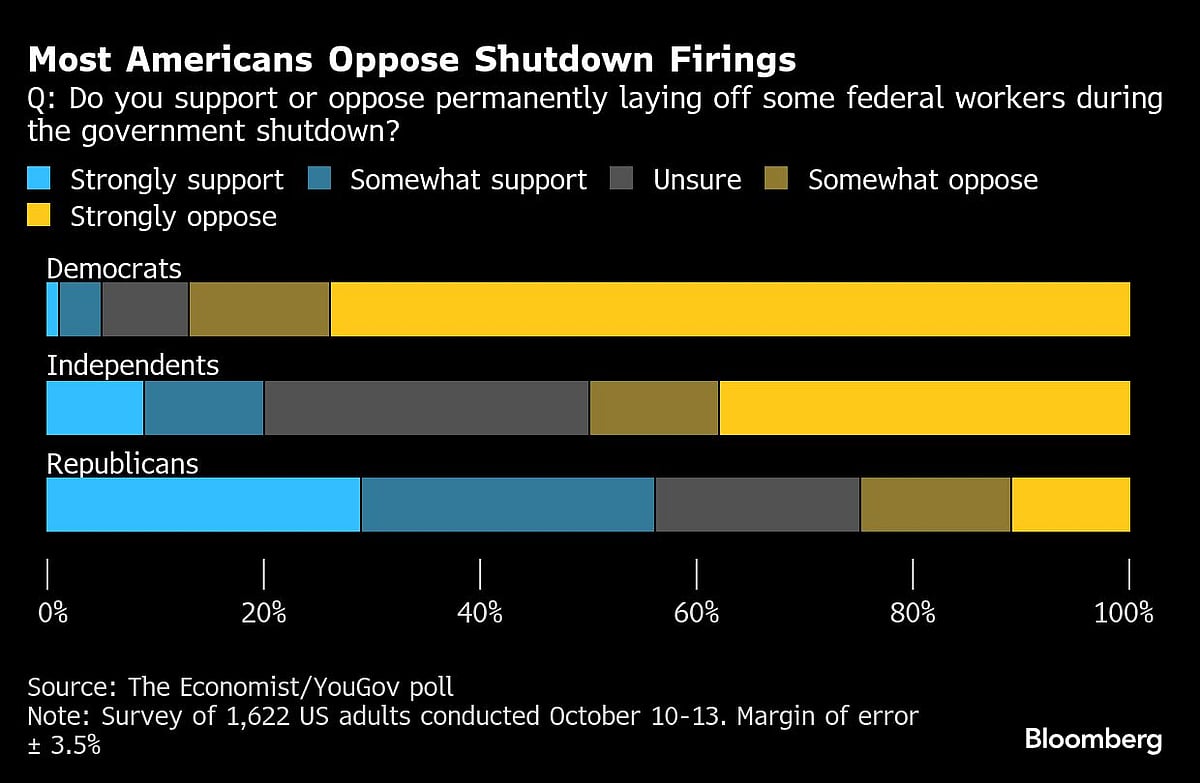Shutdown Firings Paused By Judge As Vought Vows More To Come
Trump also signed an order Wednesday that formally lifts the government-wide hiring freeze he imposed on his first day back in office.

A federal judge ordered the Trump administration to pause plans to fire thousands of federal workers during the government shutdown, just moments after White House Budget Director Russell Vought said he expects layoffs to exceed more than 10,000 people.
The ruling on Wednesday from US District Judge Susan Illston in San Francisco follows layoff notices that have gone out to more than 4,100 federal employees since last week.
The order isn’t a final decision on the merits of the case. It means that more than 30 federal agencies for now cannot send out new layoff notices if they involve programs that affect labor union members who sued.
The decision also means the government must halt action on notices that already went out while the judge weighs whether to impose a longer-term block. Illston will schedule a hearing in the coming weeks for the next round of arguments. The Justice Department in the meantime could ask an appeals court to immediately intervene and let layoffs resume while the case goes forward.
Illston, appointed to the court by former President Bill Clinton, said during the Wednesday hearing that the evidence suggested administration officials had “taken advantage” of the budget impasse in Congress to “assume that all bets are off” and that “the laws don’t apply to them.”
“It’s a human cost that cannot be tolerated,” Illston said of the mass firings.
More than 4,000 federal workers have so far lost their jobs — a number Vought called “just a snapshot, and I think it’ll get much higher.”
“I think we’ll probably end up being north of 10,000,” Vought said before the ruling.
The White House budget office has vowed to continue reductions in force — the government’s term for layoffs of federal workers. The administration has not detailed which agencies or jobs could be affected in future rounds of layoffs.
“We’re going to keep those RIFs rolling throughout this shutdown, because we think it’s important to stay on offense for the American taxpayer,” Vought told the Charlie Kirk show.
Trump also signed an order Wednesday that formally lifts the government-wide hiring freeze he imposed on his first day back in office — but replaces it with a system that keeps a tight rein on agencies’ hiring plans. Under the new policy, each agency must set up a Strategic Hiring Committee and submit an annual staffing plan to the Office of Personnel Management and the Office of Management and Budget before filling vacancies.
A Justice Department spokesperson declined to comment.
Everett Kelley, national president of the American Federation of Government Employees, one of the unions that sued, said in a statement that they are “pleased with the court’s ruling halting these unlawful terminations and preventing the administration from further targeting hardworking civil servants during the shutdown.”
Shutdown Fight
The White House has escalated the standoff with Democrats over federal spending by moving to terminate some federal workers, instead of just furloughing them as the shutdown continues. Republicans say the layoffs are necessary, an assertion that budget experts and Democrats dispute because workers aren’t paid during the shutdown.
Democrats have argued that the administration cannot spend resources during a shutdown to fire people because it isn’t essential government work.
“We believe that these firings are illegal, violate the law and will be reversed, either congressionally or by the courts,” House Democratic leader Hakeem Jeffries told reporters.
Trump also said he plans to release a list of “Democrat” programs he intends to cut as the shutdown — now in its 15th day — continues. The White House has seized the federal budget as a tool to make the shutdown as painful as possible for Democrats. Republicans in Congress have largely ceded their power of the purse to the executive branch, allowing Trump to go much further than any other modern president during a shutdown.
The mass firings are broadly unpopular with voters, who continue to hold Trump and Republicans more responsible for the shutdown than Democrats. An Economist/YouGov poll conducted Oct. 10-13 found 54% opposed the layoffs, compared to 29% in support.

Vought also used the interview to criticize the Consumer Financial Protection Bureau, where he serves as the acting head. The consumer protection agency, which is the brainchild of Democratic Senator Elizabeth Warren, was largely dismantled earlier this year as part of Elon Musk’s Department of Government Efficiency effort.
“This agency, all they want to do is weaponize the tools of financial laws against, basically, small mom and pop lenders and other small financial institutions,” Vought said.
Court action
The lawsuit focuses on a memo that the White House budget office sent to agency leaders at the end of September directing them to prepare termination plans. That guidance was based on a theory that the government is no longer required by law to carry out unfunded programs that are “not consistent with the president’s priorities,” according to the memo.
Illston called the administration’s legal stance “troublesome” during Wednesday’s hearing.
The unions argued that there is no legal authority for the White House plan to permanently shed workers and that their members were likely to face “irreparable harm” without the court’s intervention to maintain the status quo.
The Justice Department countered that there was no need for emergency court action because federal regulations already build in a delay before reductions-in-force take effect. Any harms to federal workers also wouldn’t be “irreparable” since they can pursue other legal paths to challenge firings and press for missed pay or to get their jobs back, the government said.
Justice Department lawyer Elizabeth Hedges argued on Wednesday that most federal agencies hadn’t made final plans about whether to carry out reductions-in-force, so the issue wasn’t “ripe” for the judge to rule on yet.
Danielle Leonard, a lead attorney for the unions, argued that public statements from the budget office and Trump undermined the Justice Department’s representations that decisions hadn’t been made about future layoffs. She quoted a social media post from the budget office that it “is making every preparation to batten down the hatches and ride out the Democrats’ intransigence” and that those plans included “continue the RIFs.”
Federal courts remain open during the shutdown. The Justice Department has tried to wind down civil cases involving the government because there are restrictions on when employees can work without pay, but a number of cases have continued where plaintiffs are seeking emergency action from judges.
Illston began Wednesday’s hearing by thanking Hedges for continuing to do her job even though she’s not being paid.
“It’s a shame,” the judge said.

